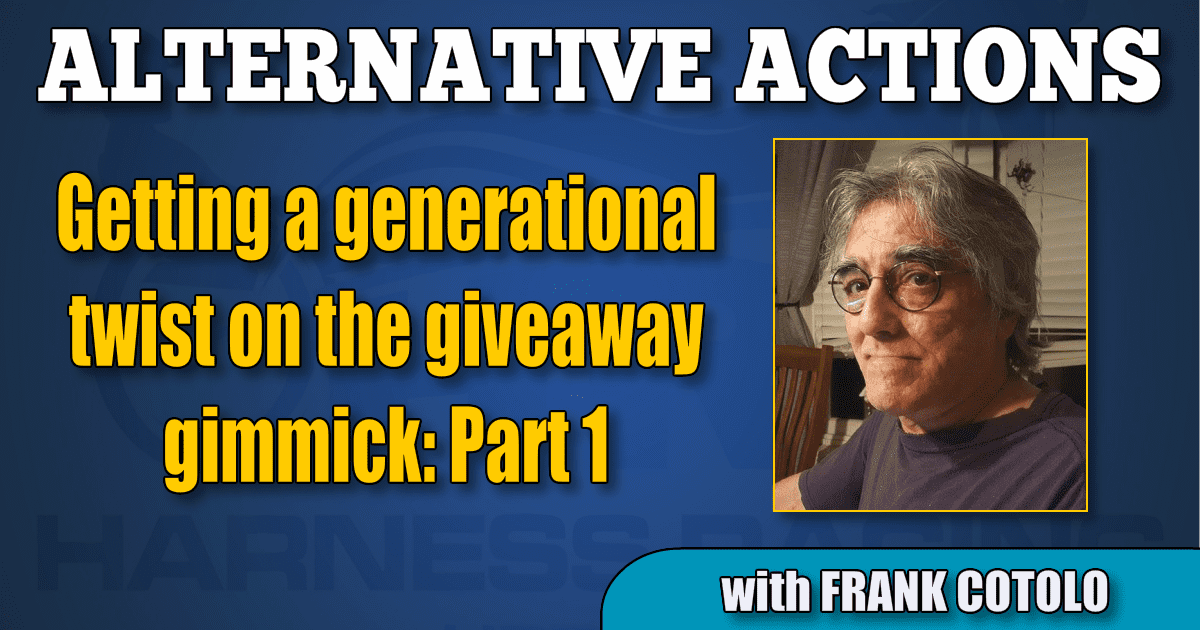Getting a generational twist on the giveaway gimmick (Part 1)
by Frank Cotolo
Giveaways have long been gimmicks employed by racetracks to attract attendance. I have never seen a study that would prove success or failure of giveaways over the decades, but I think it would be safe to say that like many other gimmicks it had a measure of success. However, in the days when an audience for pari-mutuel racing was practically a guarantee, it is difficult to assess how giveaways added to the mix.
In the new millennium, tracks’ marketing campaigns continue to enjoy using giveaways because marketers have not adjusted to the paradigm shift in legal wagering across North America, therefore losing touch with the lure of the game: making money.
Branded shirts and hats and other apparel will always be appreciated by those already stuck on the sport and the gambling game, but no complementary items magnetize the novice masses to become involved with betting horse racing regularly. Over the years, I have asked many younger folk, all age-eligible, to make wagers, if they would spend a night out at a racetrack or online with a racetrack stream with betting options, if they received free items by the track.
I found a strong percentage of those asked that said they would go to the track at least for a night when there were giveaways. Others flatly refused to commit to going without offering a reason. Granted, there is nothing empirical about my study but there are similarities in the responses that crave a full-blown study for the modern marketer to use to assess what I suspect — that giveaways do not function as bait to attract new players. Here is that list:
1—They cared about what kind of free items were involved. Some youngsters changed their minds about going based solely on the types of items. When I suggested it was free apparel (the usual shirts, hats, etcetera), the response was still “all right, I’ll go,” but the attitude was “take it or leave it.”
2—All of the responders asked if there were any conditions, that is, even though I said giveaway items means “free” for simply showing up, there were questions such as, “Do I have to stay a certain amount of time?” “Do I have to bet?” “Do I only get one of the items?”
3—A few that said they would go were surprised when I told them it was not thoroughbred racing, it was harness racing. Questions ensued: “Are those the buggy horses?” “Isn’t that the old man racing thing?” “What is harmless [sic] racing?” That last question may or may not have been the product of Attention Deficit Disorder.
4—Finally, I asked each person if they ever went or thought of going to the racetrack, even if there were no giveaways and, if not to bet, to watch any breed of horse race live. The overwhelming answer was “No.”
Even with no scientific foundation, my little study must be taken with some seriousness. After all, millennial and Generation Z (or iGen) youngsters of betting age are rarely sited at any pari-mutuel tracks anyway. Those generations are, however, the targets for all the public-relations companies that are hired to help boost attendance and betting. So, as of this writing, as far as I know (specific research on the subject will be provided in a future article), the giveaways concept is still one of the devices suggested.
If I were a track manager and an outside public relations firm suggested I use giveaways as one of their ideas to help business, I would immediately and loudly say, “Next idea.”
Unless, of course, a few new twists on giveaways were presented, some fresh and contrived versions that all involved betting.
Off the top of my head, how about a free “X” item for anyone present at the track that wins an exotic bet from a ticket worth $10 or more?
Or a free beverage for anyone present at the track that cashes a “place” bet of $10 or more.
There are numerous forms of such giveaways that will entice bettors to play a few more dollars here and there. And there is no way someone can forge a ticket to get the “item,” since winning tickets are always cashed.
There could always be lesser impressive items free on the same evening for anyone showing up at the track, just as a simple showing of appreciation (perhaps a free racing program or in-house tip sheet).
Being creative with giveaways that prompt more wagering should always be taken seriously. Add that element to be specifically aimed at younger generations by offering items to give away that appeal to those generations.
In part two of this subject, we will explore the studied purchasing characteristics of the younger generations of betting age and make some suggestions that you may not hear from a public-relations firm offering old, stale gimmicks.

















